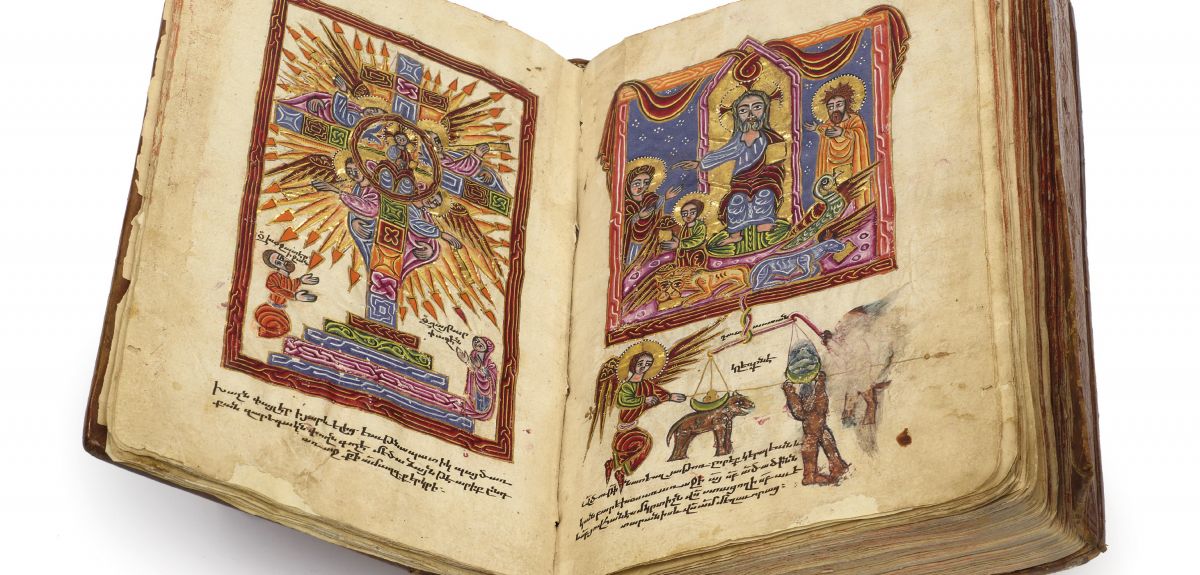
Understanding Armenia
There are three weeks remaining to visit an exhibition of Armenian artefacts which have gone on display for the first time at the Weston Library.
Professor Theo van Lint of the Oriental Institute at Oxford University and Robin Meyer of the Faculty of Classics have curated the display of items from the Bodleian Libraries' Armenian collections, in the first major UK exhibition to focus on Armenian culture in 15 years. The exhibition spans over 2000 years of Armenian history and culture, from the pre-Christian era to the genocide in the early 20th century.
'It's interesting to move from an academic perspective to consider the general public’s knowledge and interest in Armenia,' said Robin Meyer. 'For instance, the ‘Narek’ - the work of an 10th century poet - might not seem accessible, but when people learn that it’s still known and revered today – even learnt by heart – that is something interesting.'
The Narek is a work of poetry by Gregory of Narek, an Armenian saint. The exhibition features an 18th-century printed copy which has been lent by a British Armenian family, for whom the book serves as a 'Saint of the House'. It is kept wrapped in layers of silk and cloth together with other objects of reverence.
'Every step of the process of curation is informative,' said Professor van Lint. 'It involves conservation, publishing, and craftsmanship – for instance, we commissioned cradles to hold the books on display without damaging them.'
The exhibition includes books spanning several millennia, including one which records the earliest known poem in the Armenian language.
The poem, which is recorded in Movsēs Xorenac‘i’s History of the Armenians, recounts the birth of Vahagn, a god of war and part of the Armenian Zoroastrian pantheon. Very few fragments of pre-Christian Armenian poetry survive, and the 'Song of Vahagn', which describes the god's fiery hair and beard, bears some interesting resemblances to Iranian and Indian myths.
2015 marks the centenary of the genocide perpetrated against the Armenian people during World War I.
'Although we've used the anniversary of the genocide as the occasion for this exhibition, we didn’t want just to mourn, but also to use the full wealth of the collections to celebrate thousands of years of Armenian history and culture,' says Professor van Lint.
'We wanted to show that this is a country and a people that has been crucial to the development of culture and trade, and has just as rich and complex a culture as Russia or Italy, for instance, but which is much less well known in Britain.
'Armenia straddles East and West, it exists between Christian and Muslim countries, and there is a depth of human understanding borne out of existing in different circumstances there.
'Christianity underpins Armenian self-perception but there are a number of other influences: I think it’s particularly interesting that there is often a flavour of Zoroastrianism in some of the iconography, particularly with reference to the quality and treatment of light.
'We made an effort to "catch people out" with things they might not expect from a library exhibition,' said Meyer.
As well as books and manuscripts, the exhibition also includes a delicate altar-curtain embroidered in silver and a priest’s staff in the characteristic T-shape, ornamented with snakes. One display case focuses on the pigments used to illuminate books, including gold, plants and poisonous minerals.
'I certainly wouldn’t say that we chose unattractive books and manuscripts, but we didn’t want to select only the ones which immediately spring to mind,' Meyer says.
'We wanted to show the breadth of what has survived over the ages: things which are not just beautiful, but also quite moving. For instance, we have a large handwritten manuscript tracking the history of a family, which was found in 1917 and ends quite abruptly.
'This has not been fully studied, in part because the handwriting is quite difficult to decipher, but there is a lot to learn about the history of the village, including mention of feasts between Muslims and Christians, and other practices which cross boundaries in unexpected ways.'
The free exhibition Armenia: Treasures from an Enduring Culture runs at the Weston Library until 28th February 2016, and is accompanied by a series of public lectures.